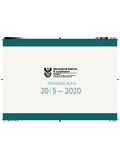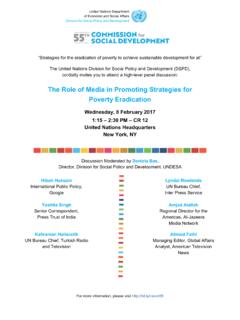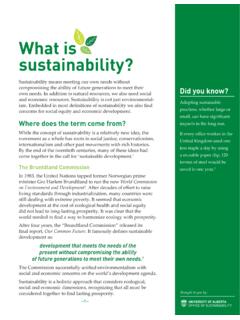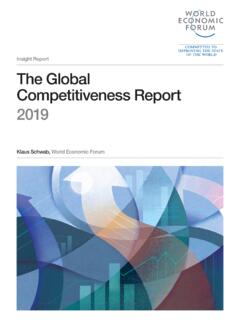Transcription of The Dynamics of Educational Reforms in the Philippine ...
1 Asia Pacific Education Review Copyright 2003 by Education Research Institute 2003, Vol. 4, No. 1, 39-50. 39 Education as a dynamic and time-tested social force has long been recognized as the mirror of historical changes. Its dynamism has shown how curricular Reforms in the school organization, modes of delivery, policy structures, and even pedagogical philosophies could be altered and enriched by forces in the environment. Changes in the social, economic, cultural, technological and political arenas are forces that every Educational system has to reckon with.
2 Failure of any school system to align its modalities to the needs of the times and the varying needs, problems and interests of its clientele may result in either entropy or atrophy. History has become Allan B. de Guzman, Director, University of Santo Tomas Center for Educational Research and Development and Professor, College of Education and Graduate School. Correspondence concerning this article should be addressed to Allan B. de Guzman, UST Center for Educational Research and Development Room 201 Thomas Aquinas Research Complex, Espa a, Manila Philippines (1008). Electronic mail may be sent to ustcerd an eyewitness as to how and why some Educational systems have failed to survive or manage to carve a name or an image.
3 The Philippine Educational System is a clear example of a boat sailing in a body of changes and challenges. It has in fact followed the same pattern of education as that of the rest of the world. It has passed through various stages of development and undergone dramatic changes depicted in the various epochs of Educational evolution. Its long years of exposure and contact with the Spaniards, Americans, and Japanese have created a spectrum of Educational variations and lines of emphasis. The impact of the three colonizers is still reflected on the present-day Educational system s thinking and practices. The Educational Decree of 1863 made possible the establishment of a complete secondary and collegiate levels of instruction; the provision for government supervision and control of these schools; and the establishment of teacher training institutions (Estioko, 1994).
4 For almost 333 years, the The Dynamics of Educational Reforms in the Philippine Basic and Higher Education Sectors Allan B. de Guzman University of Santo Tomas Philippines This paper explains the current Reforms in basic and higher education in the Philippines. Specifically, internal and external enablers in the Educational environment were reviewed as justifications of the Reforms both at the national level as well at the individual teacher. The Reforms were treated in the light of four perspectives in the measurement of quality namely; the reputational view, the resources view, the outcomes view and the value-added view. Keywords: Educational Reforms , internal and external enablers, quality views Show me a people composed of vigorous, sturdy individuals, of men and women healthy in mind and body, courteous, industrious, self-reliant, purposeful in thought as well as in action, imbued with sound patriotism and profound sense of righteousness, with high social ideals and a strong moral fiber, and I will show you a great nation, a nation that will not submerged, a nation that will emerge victorious from the trials and bitter strife of distracted world, a nation that will live forever, sharing the common task or advancing the welfare and promoting the happiness of mankind.
5 Manuel L. Quezon: 1936 (Commonwealth President) Allan B. de Guzman 40 Spaniards were successful enough propagating Christianity, thus making the country as the only nation in Asia practicing the Catholic religion. The Americans, for their part, laid down the foundation of a democratic system of education through Act No. 74. The coming of the Thomasites not only facilitated the gradual easing of feelings of rancor and animosity of the Filipinos towards the new colonizers but also has infused in them the spirit of democracy and progress as well as fair play (Martin, 1980). More importantly, with academic English Language and Literature as their focus, the American influence on the Filipino mentality has made the Philippines as the third largest English speaking nation in the world.
6 The country s exposure to the Japanese, though short-lived (1942-1945) has made the people realize the country s position as a member of the East-Asia Co- prosperity Sphere, the true meaning of establishment of a New Order in the Sphere (Martin, 1980). After the country s liberation from the hands of its colonizers on July 4, 1946, several Educational Reforms have been instituted and implemented by political leaders as part of their national agenda. These Reforms have been made as strategic instruments to realize the following Development Goals of the country (Nolledo, 1995): To achieve and maintain an accelerated rate of economic development and social progress To assure the maximum participation of all people in the attainment and enjoyment of the benefits of such growth To achieve and strengthen national unity and consciousness and preserve, develop and promote desirable cultural, moral and spiritual values in a changing world Today, Educational systems face multiple and diverse problems, among them, that of resources (Bullough et al.)
7 , 1996). Schools and school systems are being challenged to develop new Educational paradigms that will ensure survival and stability and at the same time effect the four pillars of education (Delors, 1996), namely, learning to know, learning to do, learning to be and learning to live together. Such a tall order according to Trow (1994), calls for soft managerialism , which refers to the maximum effective use of available resources. On the other hand, hard managerialism involves redirecting program efforts through the adoption of new management systems, which call for a high degree of openness in school sectors and a kind of systems thinking characterized by alignment of delivery and attunement of values and value systems.
8 In so doing, Educational systems become more responsive and resilient (El-Khawas, 2001); capable of preserving and strengthening quality (Thorens, 1996) and effecting reconstruction efforts (Castillo, 1987); and pursuing quality, equality and equity, institutional diversity, regional development, flexible curricula, stable financing, evaluation and innovation, governability, social relevance and internationalization (Gomez, 1999; Holtta & Malkki, 2000). The foregoing reality calls for a systemic kind of reform that permeates all aspects of the Educational delivery structure. The Philippine Educational System is not a system in isolation. Just like any other system of education, it is open to risks, certainties and uncertainties.
9 Its long history under the different colonizers and not to mention the varying priorities of Educational planners vis- -vis the changing Educational and social milieus has rendered it a system of vitality and reflectivity. Hence, this paper provides an avenue to explore various reform efforts initiated at the national level as shaped and influenced by variables operating in the internal and external environments of the school. The Philippine Educational System Today, the Philippine School system is said to be one of the largest in the world. The Congressional Commission on Education Study, popularly known as the EDCOM Report disclosed that enrolment at all levels was million as of 1991.
10 Recent statistics from the Department of Education (DepEd) alone reveals that as of Curriculum Year 2000-2001, the combined enrolment size in the basic education system 19,138,635 indicating the dramatic increase in and demand for education in the country. This is the resulting scenario of the country s Education for All policy and the explicit provision of the 1987 Philippine Constitution, to wit: The State shall protect and promote the right of all citizens to quality education at all levels and shall take appropriate steps to make such education accessible to all. Further, Establish and maintain a system of free public education in the elementary and high school levels.















